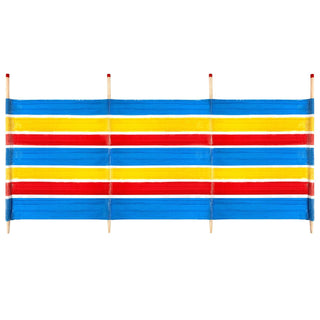Post
Share
Pin it
CAROUSSENTIALS: Beach Windbreaks and Wind Shields
Welcome along to our latest CAROUSSENTIALS edit.
The sun is shining, it's half term and, as such, it seems only right and proper that we should focus our attention on what is a quintessentially British Summer holiday requisite, and let it have its day in the sun…
We are of course referring to the wonderful, colourful beach and camping must-have that is:
THE WINDBREAK

When it comes to enjoying a day at the beach, the wind can be both friend and foe... Whilst it has the capacity to create a lovely refreshing breeze, on hot day, stronger gusts can quickly disrupt your relaxation.
Enter windbreaks - the unsung heroes of beachgoers worldwide
Origins of Windbreaks

Natural windbreakers have been used for centuries, tracing their origins back many thousands of years. Ancient Egyptians and Greeks were thought to have utilised rudimentary barriers made of plants and trees to protect themselves, their dwellings and their crops from extreme weather and strong winds.
In the UK, the use of windbreaks became popular during the Victorian era when seaside trips gained popularity among the upper classes. Static windbreakers not only protected Victorian holiday makers from the wind, but also protected their modesty on the beach.
Over the last century, windbreaks have evolved into the handy and versatile portable structures that have become synonymous with sandy shores, campsites and festivals across the country.
Benefits of Windbreaks
Windbreaks offer a multitude of benefits including:
Practical Use of Windbreaks
When setting up a windbreak, consider the following tips:

Placement: Position the windbreak at a right angle to the prevailing wind direction for optimal protection. This can help create a sheltered area while ensuring the windbreak remains stable
Height: Opt for a windbreak with sufficient height to effectively block the wind. Ideally the barrier should be tall enough to shield seated individuals in order to provide maximum protection
Material: Choose a windbreak with sturdy poles made of wood or metal and constructed using durable materials. Our range of windbreaks are capable of withstanding strong coastal winds and provide longevity
Anchoring: Secure your windbreak firmly in the sand using stakes, sandbags or weights to prevent it from being blown over by strong gusts
Maintenance: Regularly inspect your windbreaker for any signs of wear and tear, and replace or repair damaged parts promptly to ensure continued protection
Embrace the benefits and make the most of your time at the beach
In our opinion Windbreaks offer the ultimate enhancement to your beach, camping or festive experience, providing protection from strong winds and creating a comfortable and enjoyable environment.
So whether you're seeking shelter from the elements, privacy, or simply a place to relax in the shade, windbreaks are an invaluable accessory for any camping or beach enthusiast, also making them a resolute CAROUSSENTIAL!
☀️ Have a lovely rest of the week ☀️














